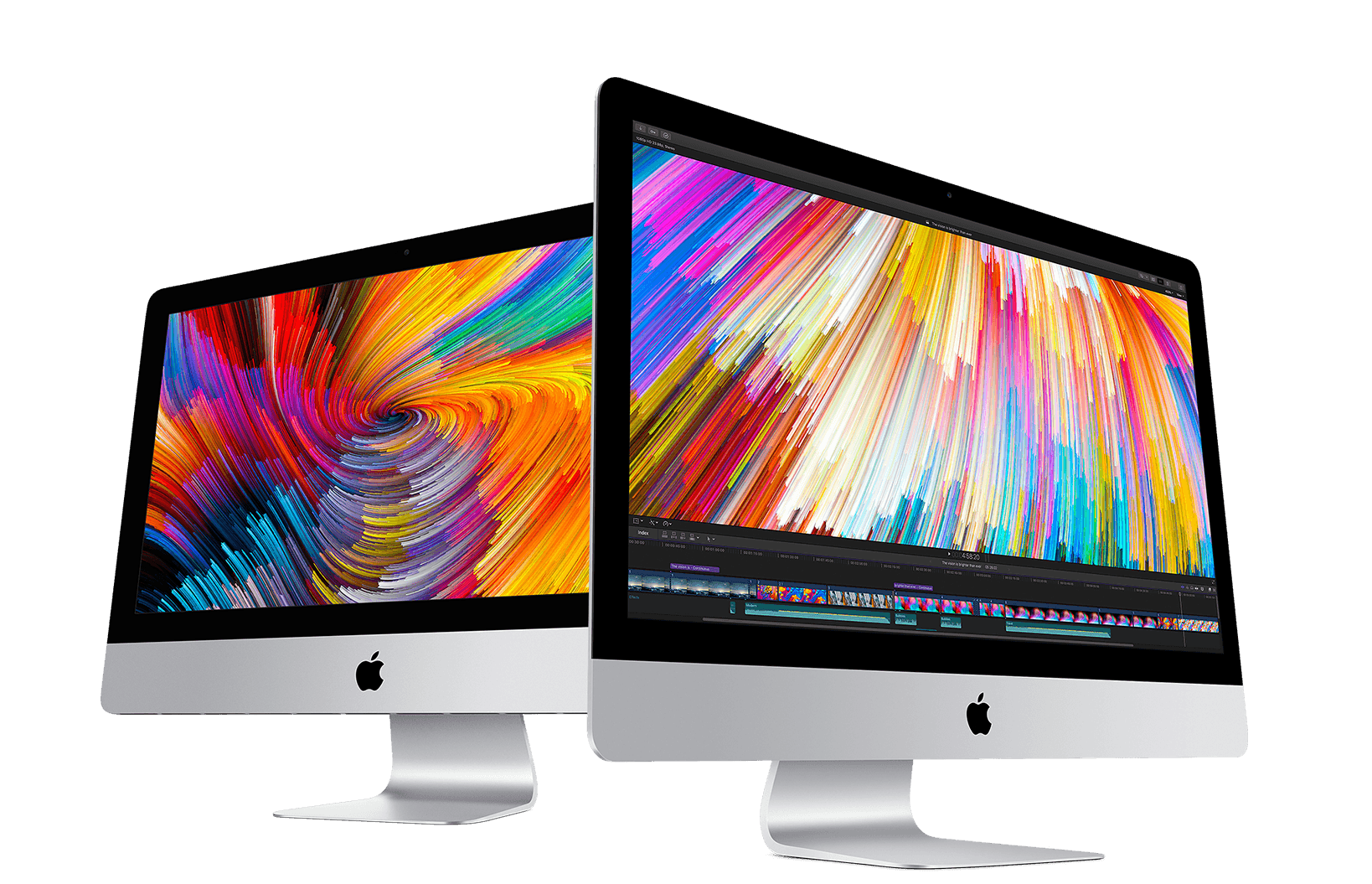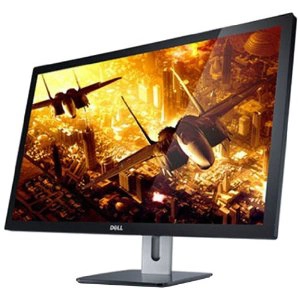Features and aesthetics
The front of the Dell S2440L is dominated by the glossy and glassy 24” screen. The face of this is seamless with an edge-to-edge glass cover and gently rounded corners. The bezel is relatively thin for a glass fronted screen, in particular, at around 17mm for all edges. The finish is highly reflective with both the glass on the outside and screen on the inside appearing to be untreated glossy surfaces. This is of course most noticeable when the monitor is switched off and facing direct light as shown below.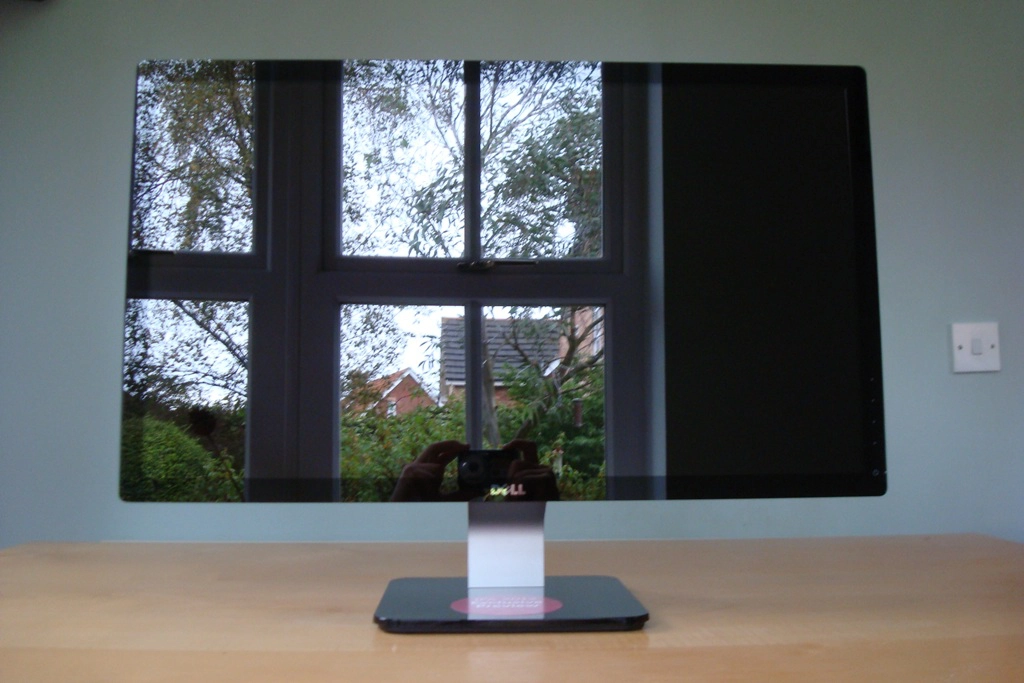
In more suitable conditions, free from strong direct light and with the monitor switched on, reflections are reduced. On bright days they could still prove problematic, though, especially when viewing dark content. The images below show the monitor switched on and displaying a dark and then a mixed desktop background. There is daylight coming in from a window to the left on a bright autumn day with the monitor set up as detailed in the calibration section. Reflections are certainly still visible on dark areas in particular and still evident to a lesser extent on lighter content.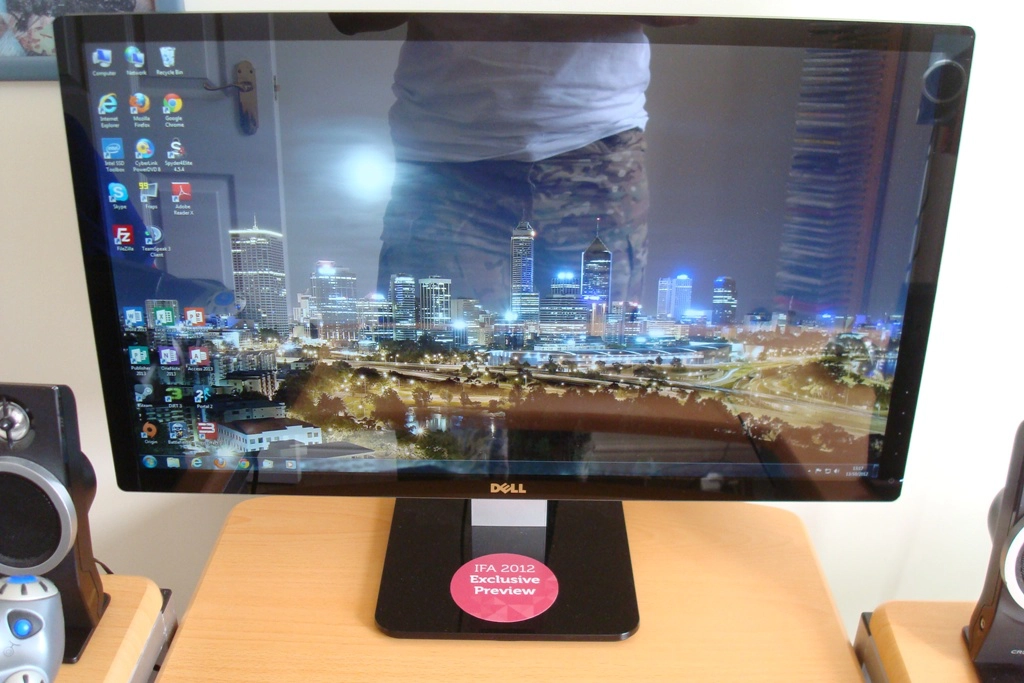
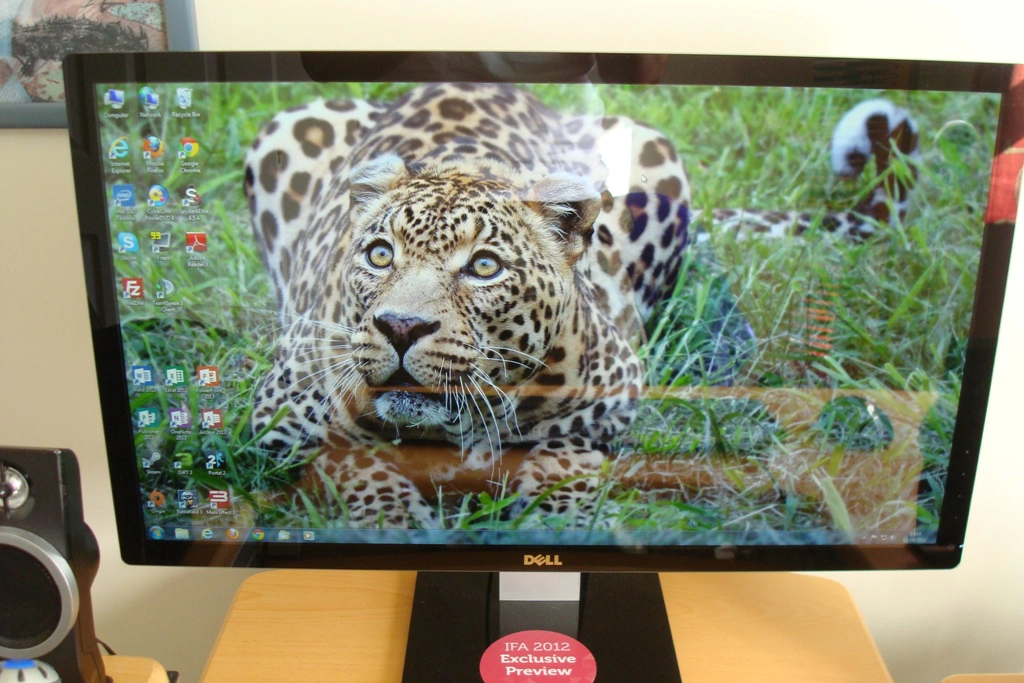
If lighting conditions are even more tightly controlled or there are lower levels of ambient light then reflections are reduced further. The images below show a dark and mixed desktop image, respectively, on a dull autumn day. It is worth remembering that Dell aren’t trying to punish users with this glossy screen surface, but rather trying to enhance the image quality of the monitor. As explored deeper into the review and in this article there are definite clarity and vibrancy benefits to be had from such a glossy solution.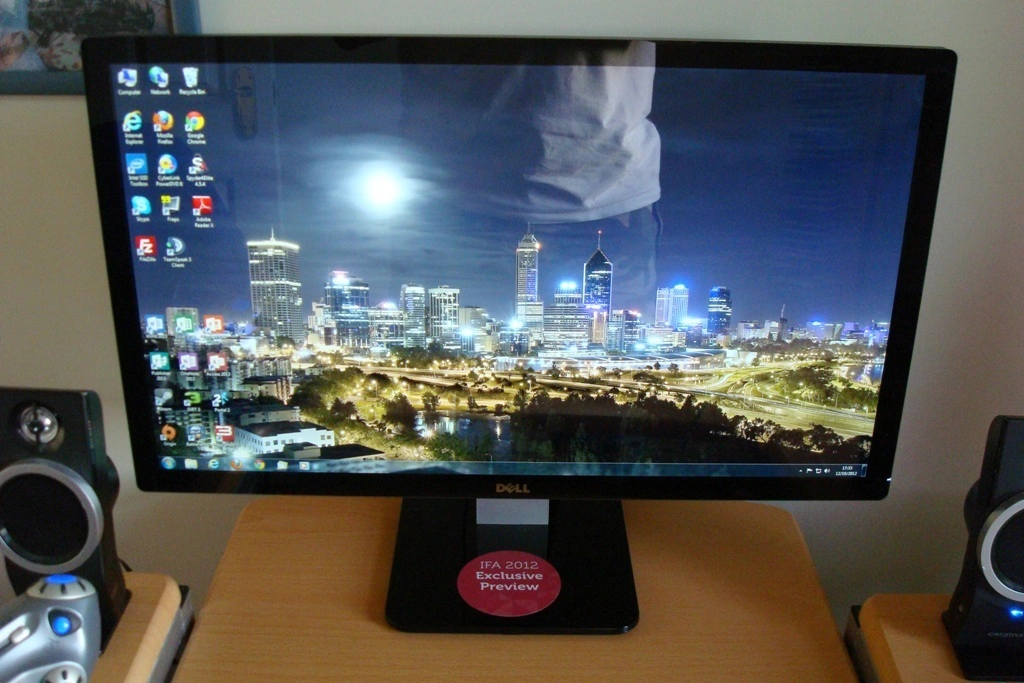
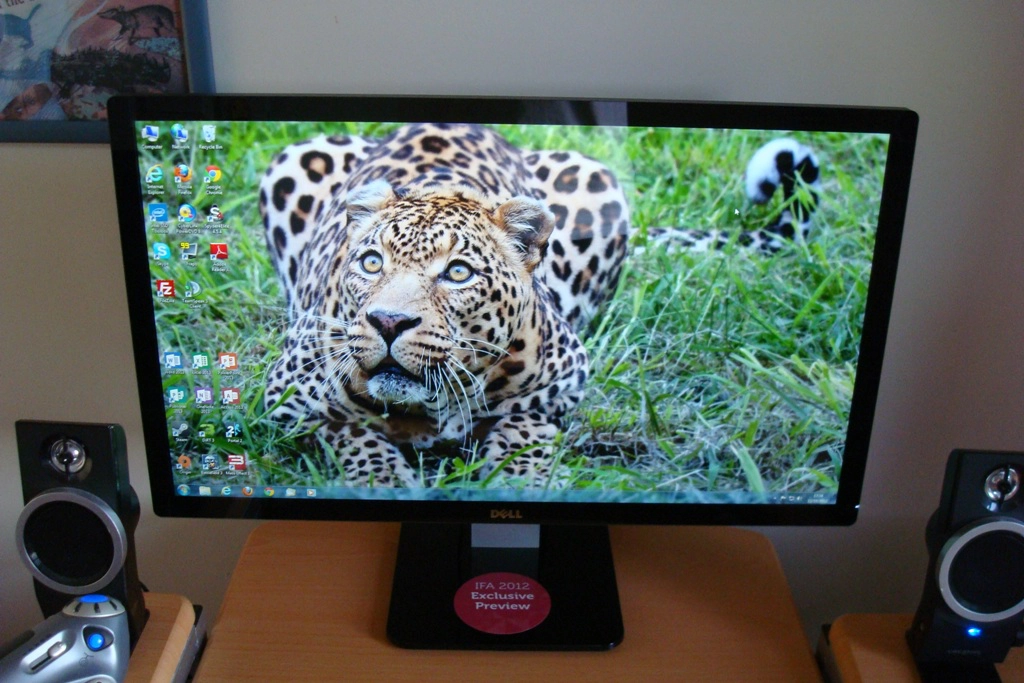
Other points of interest visible from the front include the stand, which has a very simple and flat-looking glossy black plastic base. This is attached to the screen using a silver matte plastic neckpiece. Also of significant is the touch-sensitive control area at the bottom of the right bezel edge. This proved fairly responsive to the touch with even light presses registering. There is also a touch-sensitive power button with a dim and unobtrusive white LED to the right of it to indicate that the monitor is on. This turns orange when the monitor enters standby and stays a ‘gentle’ white when the monitor is displaying an image. In the image below it appears much bluer than it does in reality but you can see how everything is laid out at least.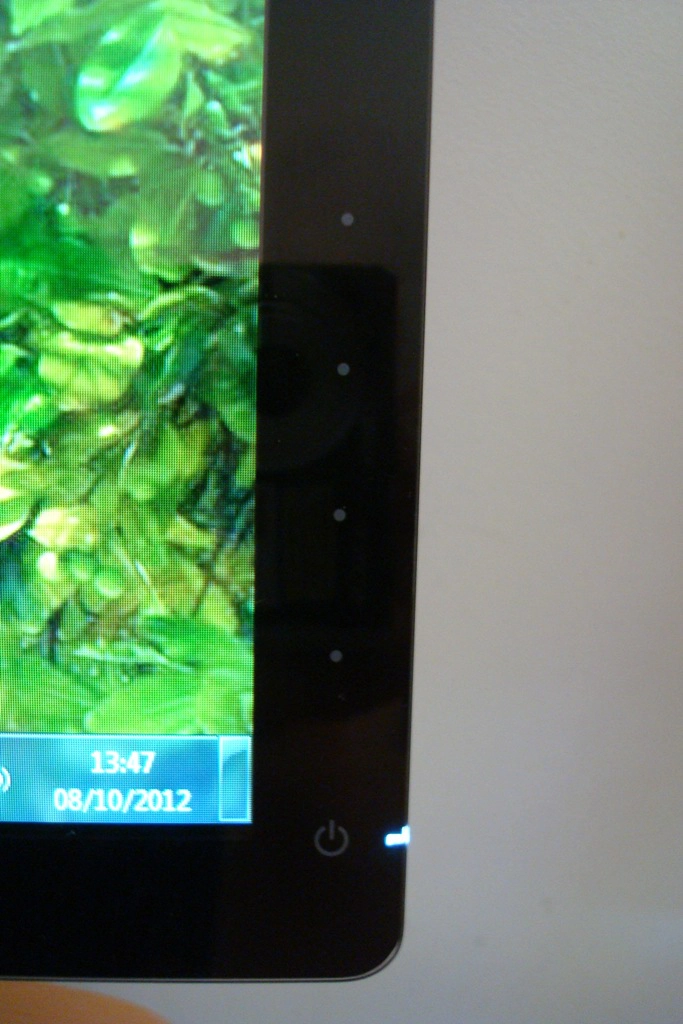
The Dell S2440L’s OSD (On Screen Display) is controlled by these touch-sensitive pads. In Dell’s usual style a single press of any of these buttons will bring up a ‘quick menu’ with 4 sections, each section belonging to its corresponding button. The first two sections (‘Preset Modes’ and ‘Brightness/Contrast’) are so-called shortcut keys which are customisable in the main menu. The key features of this quick menu and the main menu are shown in the following video. Some features are only available in certain presets and when running a VGA connection and will appear greyed out otherwise.
There is literally not a lot to the monitor from the side. You can see the glass screen cover ‘seamlessly’ transition to matte black plastic. Thanks to the WLED backlight and external power adaptor it’s only 17mm thick at the edges – although a bit thicker in the middle where the ports are located and the stand protrudes backwards.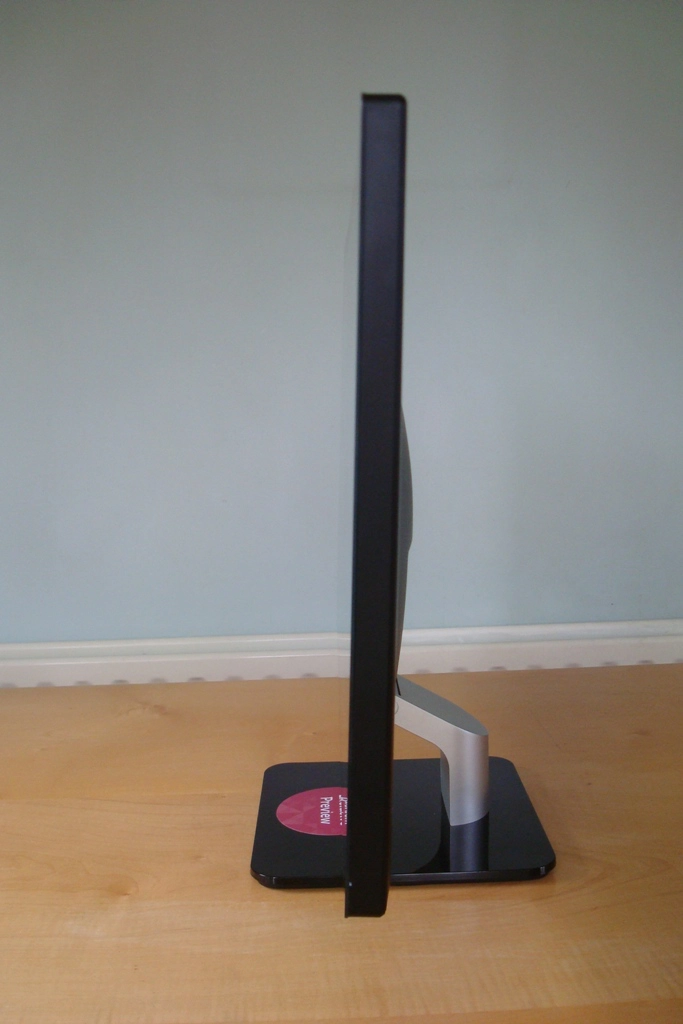
The rear of the monitor has a matte black plastic finish, complimenting the matte silver plastic stand neck and Dell logo. 
Just above the stand there is a release button, cable-tidy, information label and of course the ports (facing downwards as shown below). Although the stand is detachable there are no VESA holes on this model to allow convenient alternative mounting – another reason for its relatively slender profile.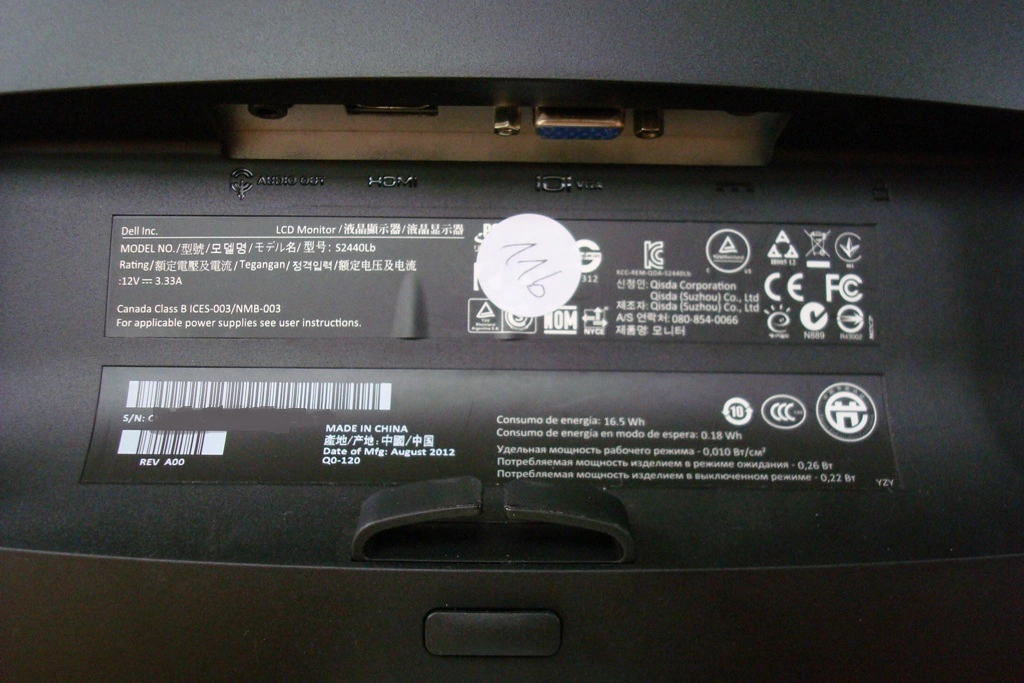
The port selection is quite limited on this model – audio out, HDMI, VGA and DC (power) input. There is also a Kensington lock socket just to the right of the ports. The monitor comes with a VGA cable and the power adaptor but doesn’t include an HDMI cable. You’ll need to use your own to make use of this digital input.
Монитор Dell S2440L Black
Большое и выразительное изображение:
Изображение на этом блестящем 24-дюймовом мониторе со светодиодной подсветкой смотрятся удивительно реалистично.
Красота и изящество: добавьте гостиной или домашнему офису утонченности и стильности. Монитор S2440L с утонченной отделкой, высоким качеством изготовления и оптимизированной конструкцией для подключения и прокладки кабелей.
Окунитесь в гущу событий.
Сверхширокий угол обзора: отличный обзор практически с любого ракурса благодаря сверхширокому углу обзора 178°/178°.Превосходная четкость: насладитесь идеально четкими деталями во время игр, просмотра фильмов и фотографий благодаря функции повышения качества изображения за счет усиления цветов. Яркие цвета просто сияют благодаря очень большому динамическому коэффициенту контрастности 8 млн:1 (номинал) и цветовой гамме 89% .Пользовательская настройка цветовой гаммы: Dell Display Manager обеспечивает высокую производительность работы благодаря быстрому доступу к программному обеспечению, такому как Auto Mode, которое позволяет выбрать предпочтительный цветовой режим для каждого приложения.Разрешение Full HD: смотрите, как благодаря разрешению Full HD (макс. 1920 x 1080) изображения с качеством кинотеатра буквально оживают на экране с широкоэкранным форматом 16:9!
Простота в работе. Развлечения в течение многих часов.
Комфорт: установка предпочтительного угла обзора благодаря широкому диапазону регулировки угла наклона. Панель S2440L можно наклонить на 4° вперед или 21° назад.Универсальность: подключение к ноутбуку или настольному компьютеру с помощью разъема VGA. Порт HDMI открывает доступ к увлекательным развлечениям в формате высокой четкости.Упорядочение окон на экране:программа Easy Arrange позволяет удобно расположить окна приложений мозаикой, чтобы они были четко видны с первого взгляда. Можно даже выбрать предпочтительную компоновку дизайна рабочего стола.
Contrast and brightness
We used a KM CS-200 ‘Chroma Meter’ to measure the luminance of ‘white’ and ‘black’ under a range of settings and calculated the resulting contrast ratio. Unless otherwise stated assume default settings were used with any dynamic contrast mode disabled. Blue highlights on the table indicate the results for our test settings whilst black highlights indicate the highest white luminance, lowest black luminance and highest contrast ratio recorded.
| Monitor Profile | White luminance (cd/m2) | Black luminance (cd/m2) | Contrast ratio (x:1) |
| ‘Standard’, 100% brightness | 245 | 0.08 | 3063 |
| ‘Standard’, 80% brightness | 212 | 0.07 | 3029 |
| ‘Standard’, 60% brightness | 172 | 0.06 | 2867 |
| ‘Standard’, 40% brightness | 127 | 0.04 | 3175 |
| ‘Standard’, 20% brightness | 82 | 0.03 | 2733 |
| ‘Standard’, 0% brightness | 37 | 0.01 | 3700 |
| Test settings, 75 brightness, 75 contrast (custom RGB) | 190 | 0.07 | 2714 |
| ‘Multimedia’ | 189 | 0.07 | 2700 |
| ‘Movie’ | 182 | 0.07 | 2600 |
| ‘Game’ | 177 | 0.07 | 2529 |
| ‘Text’ | 191 | 0.06 | 3183 |
| ‘Warm’ | 170 | 0.07 | 2429 |
| ‘Cool’ | 164 | 0.07 | 2343 |
| ‘Custom Color’ | 225 | 0.07 | 3214 |
Contrast performance on the S2440L was excellent, averaging 3094:1 under ‘Standard’ mode. This was a little lower than the rather optimistic 5000:1 specified for the panel, though. Performance in ‘Text’ and ‘Custom Color’ presets was also particularly strong (>3000:1) using their default settings. Given the fairly significant adjustments made to the colour channels for our test settings a drop in contrast was expected – but the 2714:1 recorded is still very strong. The ‘Game’, ‘Movie’, ‘Warm’, ‘Cool’ and ‘Multimedia’ presets yielded the weakest contrast ratios, ranging from 2343:1 to 2700:1. It was really the unbalanced image that was the main problem for these modes, though. Regardless of the preset being used we can confirm that the backlight does not use PWM (Pulse Width Modulation) to regulate brightness. Some people are particularly sensitive to the rapid ‘on-off’ pulses that accompany PWM backlight dimming so this will come as welcome news to such individuals.
Some users have reported receiving units which DO use PWM, whilst others have confirmed their monitors are free from PWM. It appears that Dell are using different panels, possibly from different production lines, leading to some variation here. Please get in touch if you own an S2440L and let us know if your unit is free from PWM or not. We will continue to investigate this.
By default the ‘Game’ and ‘Movie’ modes have dynamic contrast enabled which we disabled for the purposes of the table above. This reacts in a fairly natural way to changes in brightness, not too rapidly or too slowly. Although we aren’t fans of dynamic contrast in general this is one of the better implementations we’ve seen. There is also some flexibility offered in this respect. If you recall on the video of the OSD there is a setting called ‘Energy Smart’ in ‘Other Settings’. This is essentially similar to dynamic contrast but with a lower maximum luminance. Furthermore; it can be enabled in any preset.
Looking at the screen in a dark room we observed no noticeable backlight bleed. This is generally less of an issue for VA panels as they are so effective at blocking light but that doesn’t make them immune to such issues. You could see a mild purple sheen (VA glow, if you like) towards the bottom corners of the screen in a dark room which became more noticeable ‘off angle’. Unlike IPS or PLS glow this didn’t cause any substantial loss of detail in the affected areas from a normal viewing position and was not as obtrusive. You can see this phenomenon on the video accompanying the ‘Viewing angles’ section of the review.
Основные характеристики Мониторы S2440L Black
| Основные характеристики | |
|---|---|
| Цвет | Черный |
| Размер | 24 дюйм |
| Максимальное разрешение | 1920×1080 |
| Тип ЖК-матрицы | TFT IPS |
| Светодиодная (LED) подсветка | Есть |
| Дополнительно | |
| Размеры | 567x418x191 мм |
| Вес | 3,91 кг |
| Стандарт энергосбережения | Energy Star |
| Стандарты | энергосбережения: Energy Star |
| Экран | |
| Динамическая контрастность | 8000000 |
| Контрастность | 5000 |
| Время отклика | 7 мс |
| Область обзора | по горизонтали: 178°; по вертикали: 178° |
| Яркость | 250 кд/м2 |
| Максимальное количество цветов | 16.7 млн. |
| Шаг точки по горизонтали | 0.277 мм |
| Шаг точки по вертикали | 0.277 мм |
| Интерфейсы | |
| Вход VGA | Есть |
| Вход HDMI | Есть |
| Количество входов VGA | 1 |
| Количество входов HDMI | 1 |
| Питание | |
| Блок питания | внешний |
| Потребляемая мощность при работе | 18 Вт |
| Потребляемая мощность в спящем режиме | 0,5 Вт |
| Потребляемая мощность в режиме ожидания | 0,5 Вт |
Introduction
Early members of Dell’s S-series monitors were praised for their slender build and good general performance. But users are increasingly turning away from such humble Twisted Nematic (TN) panels. In recent months we have seen something of an onslaught of increasingly cheap monitors using ‘alternative’ panel types, in particular models using LG’s In-Plane Switching (IPS) technology. Another trend we have seen even more recently is a move away from ‘heavy’ matte anti-glare surfaces which impede image clarity and vibrancy and onto lighter ‘semi glossy’ and indeed fully glossy alternatives. Dell’s new 2012 S-series models really draw these trends together by doing away not only with the TN panels but also the matte screen surface.
The Dell S2440L is the ‘medium sized’ member of the new series and also happens to be the only member to use a Vertical Alignment (VA) rather than IPS panel. Companies such as BenQ have been producing highly affordable LED-backlit VA panel models of this size for some years now, with strong contrast, improved viewing angles and good colour reproduction. They have really worked hard to chip away at the traditional Achilles heel of VA panels, too, massively improving the responsiveness with some of their recent models. Dell have been studying this market carefully and aren’t prepared to go in half-hearted – their S2440L has an ace up its sleeves. With its glossy glass-covered screen surface it could really build upon the strong contrast credentials of the panel type. It is all very exciting in theory, but a lot depends on how everything has been put together. Can this monitor really fulfill its potential? That is what we shall find out.
Specifications
The basic specifications of the monitor include its previously discussed LED-backlit VA panel. This is an AU Optronics AMVA with the usual 1920 x 1080 resolution, 60Hz refresh rate and 178 degree viewing angles. It supports ‘true 8-bit colour’ and has a quoted contrast of 5000:1 which is 5 times higher than what you would see quoted for TN and IPS technology. Dell have also included grey to grey acceleration which is useful given that this is intended to be an ‘entertainment monitor’. For this they quote 6ms, so nothing too bold there then. The RRP of the monitor is also fairly enticing at around £200 ($230) at time of review – with limited retail availability that is expected to pick up.
These key ‘talking points’ of the specification have been highlighted in blue.
Screen size: 24 inches
Panel type: AU Optronics M240HVN01 V0 AMVA (Vertical Alignment) LCD
Native resolution: 1920 x 1080
Colour support: 16.7 million (8-bits per subpixel without dithering)
Response time (G2G): 6ms
Refresh rate: 60Hz
Weight: 4.95kg
Contrast ratio: 5,000:1 (8m:1 dynamic)
Viewing angle: 178º horizontal, 178º vertical
Power consumption:18W typical
Backlight: WLED (White Light Emitting Diode)
Typical RRP as reviewed: £200 ($230 USD)
Calibration
By default the image was overly ‘cold’ looking and lacked some depth and balance. It was quite bright but not eye-piercingly so during the daytime. We used some familiar images, a Spyder4Elite colorimeter, the Lagom website and observed various games and movies to ascertain what corrections if any could be made to the image. To put it bluntly, most of the presets messed up the image in various ways by crushing shade variety, oversaturating colours, further upsetting white balance and applying excessive sharpness. And the options to alter these things were greyed out! One preset we did find particularly useful, though, was ‘Custom Color’ – aptly named as it allows you to adjust individual colour channels for red, green and blue.
During out testing we also discovered an interesting little ‘trick’ with this monitor. This only applies to AMD GPUs such as the Radeon 7950 used on our test system. When connected via the monitor’s only digital input (HDMI) we navigated to ‘Catalyst Control Centre –> My Digital Flat-Panels –> Pixel Format’ and changed this from the default ‘YCbCr 4:4:4 Pixel Format’ to ‘RGB 4:4:4 Pixel Format PC Standard (Full RGB)’. The screen then re-established connection and lists ‘RGB’ for the input colour format in ‘Color Settings’ on the monitor’s OSD. This didn’t alter the colour significantly (we checked for tell-tale signs of colour signal range issues) but added a little extra contrast – around 150:1 extra which is a nice little freebie. The setting to change is shown in the screenshot below.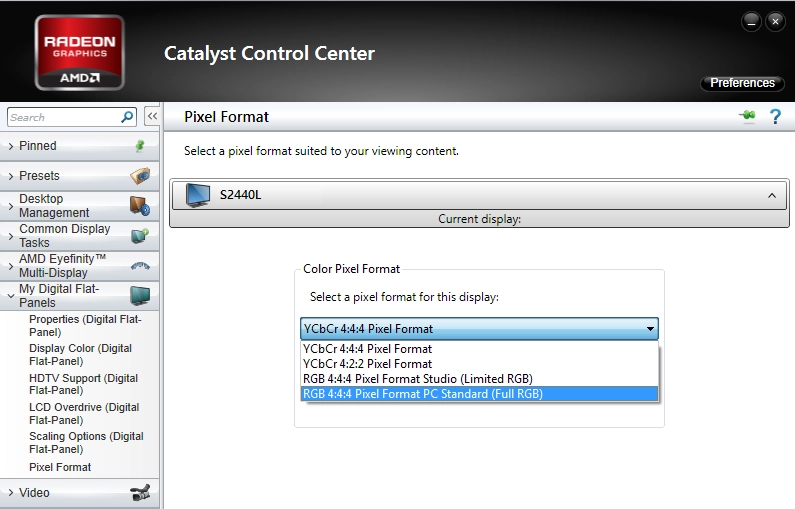
Interestingly Nvidia GPUs respond very differently. They use ‘RGB’ by default over HDMI but it seems to be quite a messed up signal for Nvidia cards on the S2440L. The low-end shades become crushed and, most significantly, black is displayed as a murky grey – yielding an abysmal contrast ratio of around 300:1 under default settings. This can be resolved by navigating to ‘NVIDIA Control Panel –> Adjust desktop color settings –> Digital color format’ and selecting ‘YCbCr444’ as shown below.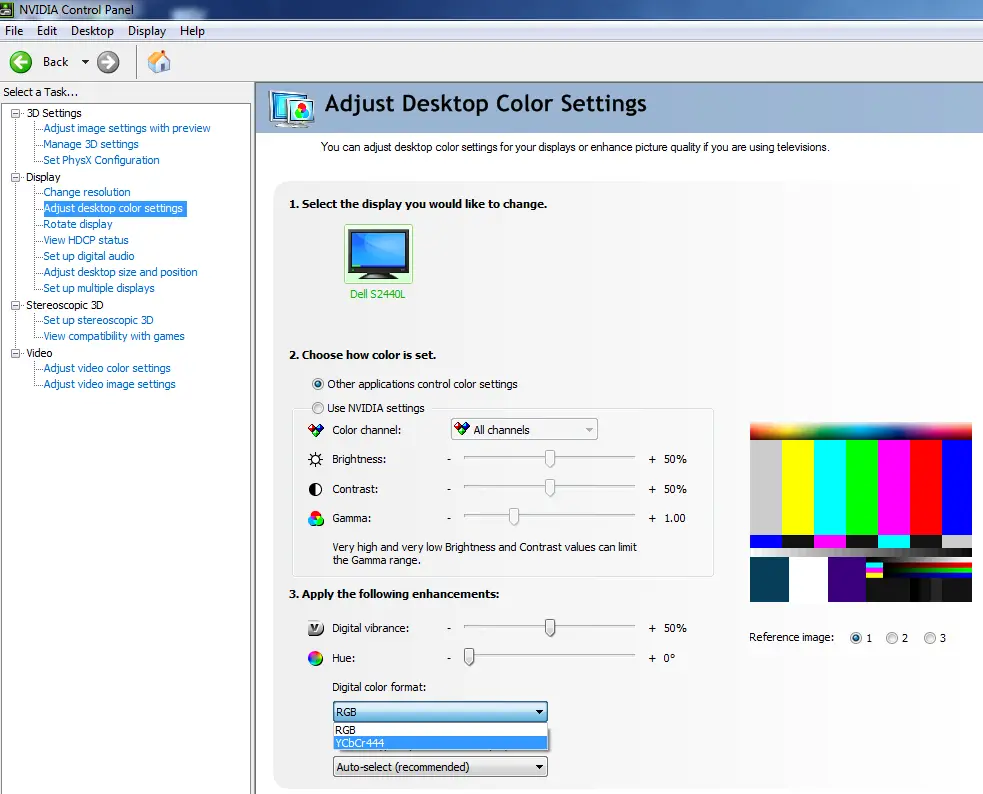
It was strange to have to make this correction given that the YCbCr444 signal can sometimes have undesirable consequences such as limiting colour range. We carefully analysed shade range at the often-affected low end in particular and cross-compared with the AMD card’s RGB and YCbCr 4:4:4 settings. There was no observable negative effect. The contrast was now raised significantly and the overall image was quite comparable to on the AMD card. We settled for the following settings for both cards – but all subsequent analysis is done on the AMD Radeon 7950 as per usual.Preset Mode= Custom Color
Brightness= 75 (according to preferences and lighting)
Contrast= 75
Red= 100
Green= 90
Conclusion
The Dell S2440L is quite a unique monitor really, combining an LED-backlit VA panel with a glossy edge to edge glass display. The glossy surface not only looks quite fetching on the outside, it allows the monitor to display its image directly without the light being diffused by matte surface. The colour balance on the monitor needed some correction and so did the pixel format for HDMI on the Nvidia graphics driver. Once that was done the image was clear and crisp with well-defined and inky looking blacks and a pleasing variety of good solid-looking colours. Coupled with the strong contrast performance, where we measured an average of over 3000:1, the monitor certainly had a lot to flaunt. We were particularly impressed with how it handled deep blues and reds – although the balance was some way off under default settings and we did have to make some fairly significant colour balance adjustments on our unit. On the flip side the monitor was highly glossy. With no anti-glare filter beneath and no noticeable anti-reflective qualities, either, you would certainly want to use it in a controlled lighting environment. Bright ambient light, particularly when displaying dark content, would cause the viewer to become part of the picture.
The responsiveness of the monitor was also pleasing in some ways, but had its caveats. We observed exceptionally low input lag and many pixel transitions being handled well. This is certainly an area where modern VA panels have shown a lot of progress – there were instances where you would feel you were using an overdriven IPS or TN rather than a VA panel. But these transitions were handled by an aggressively implemented pixel overdrive algorithm which, unfortunately, is no magic bullet. Some pixel changes are natively very slow on VA panels (high contrast ones between dark and much lighter colours) and these ones didn’t show such clean acceleration. Overdrive artifacts such as dark trailing (overshoot) became prominent where such transitions were dominant.
So there are some compromises for serious gamers and image editors, or indeed those with uncontrolled lighting environments. But for those that like to dabble in a bit of everything and are looking for a relatively affordable but high quality monitor then this is one to look out for. It isn’t perfect (which monitor is?) but the Dell S2440L is quite a unique product with a lot to offer.
| Positives | Negatives |
| Excellent contrast performance with good black depth and a bright, clear and clean image | Contrast ratio fell short of the optimistic 5000:1 specified by panel manufacturer AUO |
| A good range of shades and a good level of vibrancy from this glossy VA panel monitor | Colour consistency and viewing angles not as good as on IPS or PLS and default colour balance not ideal |
| Very low input lag and some good pixel responsiveness shown | Some pixel transitions were problematic, causing a noticeable dark trail (overshoot) |
| A nice look to the screen with a clean design and edge-to-edge glass. Also a competitive price tag | Limited stand adjustability and connectivity, no VESA mounting and reflections on the screen can be a problem |
As an Amazon Associate I earn from qualifying purchases made using the below link.
|
|
Donations are also greatly appreciated.
Viewing angles
Our subjective testing of the monitor suggested that colour consistency was placed some way between TN and IPS/PLS technologies, as you would expect from a VA panel. The Lagom test for viewing angles helped confirmed that this was the case and excellent tests for highlighting any particular weaknesses in this area. This aspect of a monitor is particularly important for colour-critical tasks, for example.
- The purple block appeared purple for the most part with slightly pink flanks at either side.
The red block appeared predominantly a cherry red with a slight pink tinge at the far left and right edges. The bottom right corner in particular took on a pink hue.
The green block appeared a slightly yellow green throughout and was quite consistent.
The blue block was an unmistakable blue throughout.
The Lagom text appeared a blended grey and dull red without noticeable hints of green. This indicates a higher level of viewing angle dependency to the gamma curve than IPS/PLS (would appear a blended grey) but lower than TN matrices (green towards the top and red towards the bottom).
We also took a look at the influence of off-centre viewing angles on performance on the Lagom text and on the general image quality. The following video shows the results of the text test, a mixed desktop background and a dark desktop background from a variety of viewing angles. The mixed desktop background is probably the best at showing the contrast shift that occurs at decentralised angles both horizontally and vertically. This shift was stronger than on IPS and related technologies but weaker than on TN – note the lack of colour inversion vertically which distinguishes this from the latter. The dark image shows the purple sheen of what could be considered ‘VA glow’ which intensifies off-angle. This was not as prominent or intense as the sheen of IPS glow which tends to bloom out readily and is much more significant from direct viewing positions.
